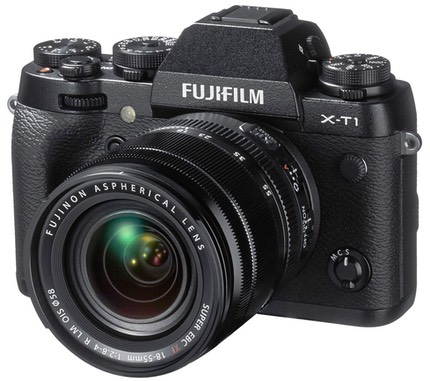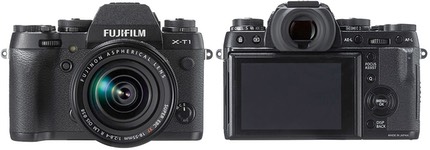
Fujifilm today officially announced the camera they've been teasing for weeks now, the X-T1. This 16mp X-Trans II sensor camera is styled like a DSLR (mid-camera prism hump), and a retro one at that (widespread use of traditional dials instead of buttons). While Fujifilm technically has positioned this camera between the X-Pro1 and the X-E2, the X-T1 is in my mind the new top of Fujifilm's lineup. It has far too many improvements over the X-Pro1, with the only thing the X-Pro1 having that the X-T1 doesn't is the optical/electronic viewfinder.
The X-T1 has a lot of strong features: 2.36m EVF with high refresh (54 fps under all conditions), faster startup and cycling times, 8 fps with focus tracking, improved focus over the X-E2, an optional VG-XT1 battery grip, and new for Fujifilm: a weather sealed body. Other highlights include WiFi support (including remote operation), ISO that now goes to 51,200 for JPEGs, faster card support via UHS-II, a tilting rear LCD, and information that rotates in the EVF when the camera is held in portrait position. The camera is a little bigger and 90g heavier than the X-E2.
The weatherproofing is said to be dust and water resistant, and freeze proof (to 14°F). Fujifilm also made "fastest" claims for the autofocus system, though as we've come to learn over the years, those are all footnoted (APS sensor mirrorless bodies) and are somewhat optimized claims. Suffice it to say that Fujifilm claims faster focus than previous X cameras, some of which were getting quite responsive. It appears to have reasonable continuous focus, though this is only via the most central area in the viewfinder.
Along with the X-T1 Fujifilm also announced their first weatherproof lens, the 18-135mm f/3-5-5.6 OIS. This new lens will be available in June as a kit lens option for the X-T1.
The X-T1 will sell for US$1300 body only, or US$1700 with the 18-55mm f/2.8-4 lens, and be in stores in mid-February.
For Fujifilm fans, the question has to be: X-E2 or X-T1? For US$1300, the X-T1 is adding weather proofing, a tilting rear LCD, an optional vertical grip, faster raw write speeds, and improvements in focus performance. But it's also bulking up a bit. Is that enough? I'm not sure; it would almost certainly be a personal decision based upon a value determination. Personally, I think the X-T1 needed a little more to set itself apart. What that "little more" would be turns out to be a good question. There are a lot of subtle issues with the X series still. The 1/180 flash sync speed, for instance. It would have been nice to see more of those addressed in the X-T1. Flash is still a weak point in the X system.

We're now in a tricky spot in the market for interchangeable lens cameras. The Olympus E-M5 and E-M1 (and tomorrow's E-M10), the Fujifilm X-E1/2 and X-T1, and the Sony NEX-6/7 and A7/A7r have all put in strong challenge statements to DSLRs. I get a lot of email every day from Canon and Nikon DSLR users either inquiring about whether they should switch to a mirrorless camera or indicating that they're already in the process of switching. Quite frankly, a lot of this is chasing the greener grass syndrome. So let me make a few generalized comments.
First, as of today, the best balanced interchangeable lens camera that is capable of the best possible image quality is the Nikon D800. It has been since it was announced nearly two years ago, and it continues to be the camera to knock off today. Of course, it's a US$3000 camera that we can put US$14,000 lenses on, so it ought to be good ;~). The Sony A7r may have the same sensor, but it's not quite the same camera when you do a head-to-head comparison (e.g. slower focus, slower frame rate, etc.).
But even the crop-sensor DSLRs have come an extraordinary long way in a short time. It's difficult to top the image quality you can get out of a Nikon D3300, D5300, or D7100 with the right lenses (which almost certainly aren't Nikkors). It's even difficult to come close to matching their focus performance (when set and used properly). It's a shame that Nikon has neglected the lens set. (I'd probably say the same thing about Canon DSLRs if I had more experience with the entire line of their products; unfortunately, I've only used one current Canon DSLR recently, so I'm going to refrain from generalizing with their line; everything I write on my sites about performance of products is from direct experience and observation, not speculation or guesses.)
Are the high-end mirrorless cameras like the X-T1 nibbling away at the crop DSLR advantages? You bet they are. Plus they come with some advantages of their own: smaller size, lighter weight, better weather sealing, sensor stabilization, very fast and accurate single shot focus, better lens selection in the wide angle, normal, and prime categories, and the benefits that a live EVF provide (live histogram, for example). Note that not all mirrorless cameras have all those advantages (the X-T1 Fujifilm announced doesn't have sensor stabilization, for example). But most have many of them.
At the same time, the high-end mirrorless cameras have a few disadvantages to DSLRs still. In particular: higher prices for equivalency, lower pixel counts, less capable continuous autofocus, shorter battery life, weaknesses in the telephoto lens lineups, and more.
As always with tools, you have to pick the one that's best suited for what you need to do, and that you can afford. Considering that we have extremely capable US$600 DSLRs now, that second part still seems to be a weakness of the high-end mirrorless systems. After all, today's X-T1 is US$1300 for the body only, and the Fujifilm X lenses aren't exactly inexpensive, so you're usually committing a lot of dough when you stretch into one of these new mirrorless systems instead of a DSLR.
I write all this not to keep you from buying an X-T1: it seems like a great little camera and I look forward to trying it out. I'm extremely happy to see Fujifilm pressing forward as fast as they have with the X series cameras, and I know they're listening to customers as they do. Still, I caution folk not to get caught up in the hype of "new" and try to evaluate these additional tools from a less emotional and more pragmatic attitude.
In particular, the Fujifilm X-T1 is a 16mp camera. We have yet to see fast and solid telephoto options for the X mount. It's priced higher than a Nikon D7100, which is one heck of a good camera. I won't fault you if you pick an X-T1 (or other high-end mirrorless) over a DSLR for the right reasons, just make sure you know what those reasons are and that you're not giving up something important to you.
Support this site by ordering your X-T1 from this advertiser:



